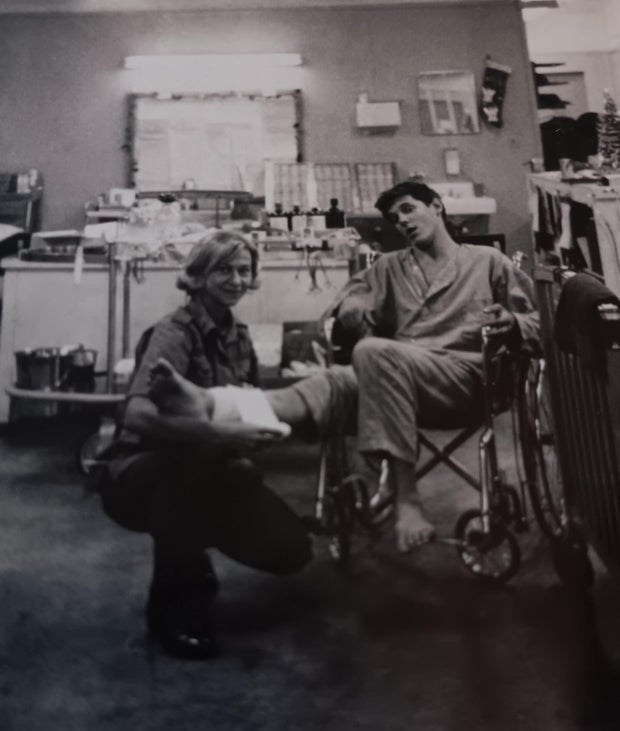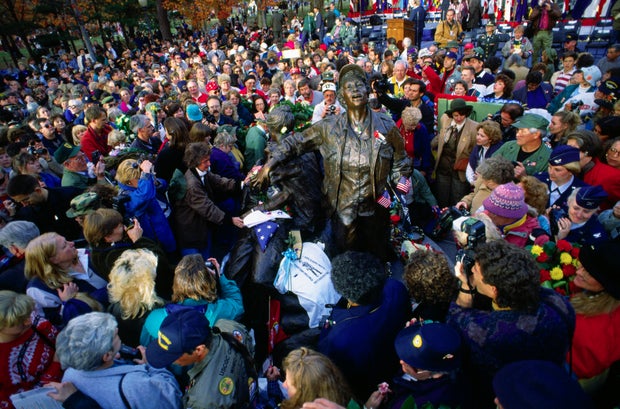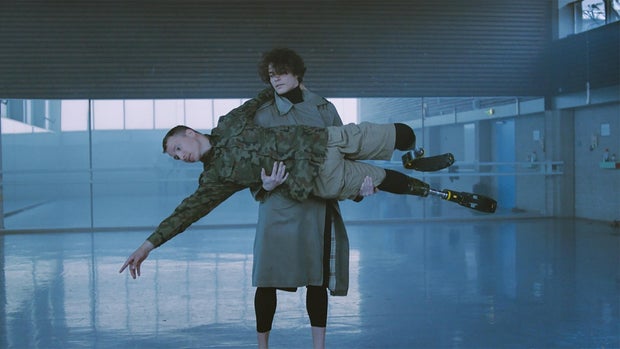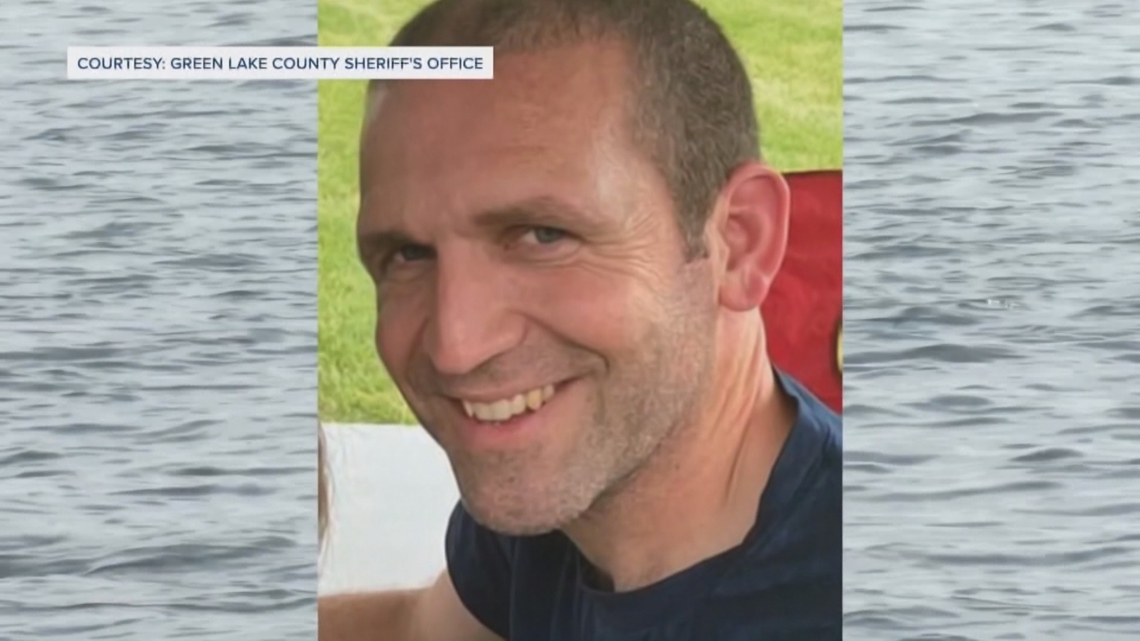CBS News
What veteran Army nurses say about their experiences serving in Vietnam

Between 1967 and 1968, Nancy Wells spent her waking hours stitching injured Americans back together amid the haze of the Vietnam War, treating wounds she’d never imagined seeing.
When not on the hospital wards, Wells and her fellow nurses lived like other soldiers: They ate at the same mess hall, slept in the same Quonset-hut dorms, called hooches, and were jolted out of bed by the same alarms and explosions. Some nurses suffered from post-traumatic stress disorder. And all were subject to the same upheaval and protests when they returned stateside.
Yet after the war, there was far less support and community for nurses and little recognition from the public of what they went through overseas. On Veterans’ Day, nurses gather at the Vietnam Women’s Memorial, which was built in 1993 after years of advocacy, to honor the service of the “forgotten veterans.”
“It seemed like the choppers would never stop coming in”
About 7,000 American women served in Vietnam as nurses during the war. Many, like Wells, were recruited from nursing school. Those who completed the Army’s student nurse program and passed state nursing exams were commissioned as Second Lieutenants in the Army Nurse Corps. While overseas, they often served in multiple hospitals during one-year tours. Wells worked at the 85th Evacuation Hospital in Qui Nohn and at the 71st Evacuation Hospital at Pleiku. There, she said, red alerts that meant enemy and hostile fire in the area became a part of daily life.
“You’d have to throw on your steel pot (helmet) and your flak jacket and go over to the hospital wards” when the alarm went off, Wells, now 80 and living in Michigan, told CBS News. “The siren would be blaring. Initially, it was a little frightening. You could hear the gunfire off in the distance. But after enough red alerts, you kind of became used to it.”
Nancy Wells
Even when the world around them was calm, there were always soldiers in need in the hospital wards. At the 71st Evacuation Hospital, there often weren’t enough staff members to cover the 400 beds. Wells said she and her fellow nurses would work six or even seven days a week there, “depending on the casualties coming in.” During one period in November 1967, she said there were three weeks of nonstop casualties, coming so fast that medical personnel were flown in from other locations to help the 71st. During this period, the Battle of Dak To was taking place in Vietnam’s Central Highlands. It was one of the bloodiest battles of the war.
“There were days when it seemed like the choppers would never stop coming in with the wounded,” said Wells. “Those were hard days, and the wounds the guys were coming in with were horrendous.”
In January 1968, the hospital was in the path of the Tet Offensive, a major military campaign by Vietnamese forces. Some hospital wards at the 71st were closed because “it was felt that we were in too dangerous of an area to keep very many wounded” soldiers, Wells said. Meanwhile, Wells and her other nurses moved into the hospital, because it was deemed a safer place than their hooches.
Even when the crises slowed down, nurses like Wells had duties that went far beyond what they might do at a hospital in the United States. Wells said doctors assigned to the wards might only be there once or twice a week, so nurses would write orders for infection treatment and pain medications. They also cared for delayed wound closures, which meant carefully monitoring a non-critical wound for a week before it was surgically repaired. Medical personnel also did outreach work, treating injuries and giving vaccinations to some Vietnamese civilians when conditions allowed.
Nancy Wells
On top of that, the nurses passed medications, checked IVs and bandages, gave injections and did everything they could to keep soldiers’ spirits high. For Wells, caring for the soldiers she affectionately calls “her boys” meant sometimes skirting regulations.
“One of my boys came up to me in his wheelchair, and he said, ‘Ma’am, is there anything to eat?’ I’m hungry.’ I told him ‘No, but I know where to get some food,'” said Wells. “This was late at night. I snuck down to the chow hall, and didn’t see anybody, so I took an entire sheet cake and took it back up to the ward so my boys could have a midnight snack.”
“We didn’t send women to Vietnam”
Wells came home from Vietnam on Easter Sunday in 1968. Her supervisor recommended she change out of her uniform to avoid negative attention in the airport, but she was determined to “walk tall” as she reunited with her family.
Soon, though, Wells realized she was having a hard time adjusting back to civilian life. It took two months before she could bear to work as a nurse again, and she felt that she could no longer connect with her old friends. Whenever they talked about parties and beauty salons, she could only think about the conditions she had spent the past year in — the conditions her “boys” were still experiencing.
She and her husband, a fellow Vietnam veteran, both struggled to talk about their experiences in the country — something she said likely contributed to their divorce. She struggled to sleep at night, and couldn’t bear being in a large crowd or hearing the sounds of helicopters. Wells would later be diagnosed with and treated for PTSD.
In 1980, she felt she was ready to connect with other veterans, so she went to her local VFW. She had identification confirming her service but was rebuffed and told she could join the Ladies Auxiliary, a volunteer group for women and family members who did not serve. The organization was rebranded as the VFW Auxiliary in 2015.
“I walked into the building, I was met by a gentlemen … and told him that I wanted to join. And he said ‘The VFW is for veterans,'” Wells recalled. “He couldn’t believe that I was a veteran, just the same as he was. I walked out and never went back.”
That wasn’t an unusual experience for nurses coming home. Constance Evans, who spent a year serving at the 12th Evacuation Hospital in Cu Chi, said she was invited to join the Ladies Auxiliary, but not welcomed into her local VFW in Idaho. She spent months campaigning to be part of the latter organization and was eventually accepted. Evans, who is part of the Nez Perce tribe, said she was also excluded from a tribal ceremony honoring veterans for years. Donna Barbisch, a former Vietnam nurse and retired Army officer, remembered talking to a woman who didn’t know any American women had been overseas.
“She was expressing negative sentiment about the war, and I told her that I thought she had some of the facts mixed up,” Barbisch, 77, who lives in Washington, D.C. now, recalled. “And she said ‘Oh, how would you know?’ I said ‘I was there.’ She said, ‘Oh, no, you weren’t there, we didn’t send women to Vietnam.'”
“‘Yes, I am a veteran'”
For decades, Wells and other nurses who served in Vietnam tried to put the war out of their heads and get on with life at home. Some, like Barbisch, went back to the Army. Others, including Wells, returned to civilian medicine. Many nurses who had served together lost contact. Some received services through the VA, though Evans said it took years of fighting and appeals to have her post-traumatic stress disorder considered a disability by the agency.
All of the women interviewed for this story said that their work during the war and the struggles they experienced afterward were something they rarely talked about, even with close friends and family.
That changed in 1984 when Vietnam veteran Diane Carlson Evans co-founded the Vietnam Women’s Memorial Foundation with two other former nurses. The foundation began lobbying Congress to erect a memorial honoring Vietnam nurses on the National Mall in Washington, D.C. Congress approved the construction of the statue in 1988, and the memorial was dedicated on Veterans Day in 1993. Thousands of veterans, including Wells, participated in a march that culminated at the memorial, which shows three nurses caring for fallen soldiers.
© Wally McNamee/CORBIS/Corbis via Getty Images
“We marched down Constitution Avenue, and people were lining the streets shouting ‘Welcome home, welcome home,'” Wells said. “One woman came up to me and said ‘You saved my husband.’ And that was great. It was amazing, it was uplifting.”
The legacy of the Vietnam nurses is now remembered with statewide celebrations and annual gatherings at the memorial. It’s a welcome change from the silence and shame that accompanied their initial return home, Evans said.
“It really helped me come out and say ‘Yes, I am a veteran, and I served in a war,'” she said. “I finally became very proud of what I did.”
CBS News
Canadian teen in critical condition with suspected case of bird flu

A Canadian teen is hospitalized in critical condition with what is believed to be bird flu, a British Columbia health official said Tuesday.
It’s not clear how the teenager picked up the virus, which has been detected recently in wild birds and poultry in the province, said Dr. Bonnie Henry, provincial health officer. The teen is not known to have any contact with infected animals, she said.
Officials have released few details about the patient. Henry said the teen was healthy before developing symptoms more than a week ago — initially eye redness, cough and fever — and has been hospitalized with a respiratory illness since Friday in Vancouver.
Initial testing indicated the infection is from bird flu. Officials believe it is the Type A H5N1 bird flu, but are awaiting confirmation. H5N1 has been spreading widely in the U.S. among wild birds, poultry, cows and a number of other animals.
In Canada, testing has been done on about three dozen people who were in contact with the teen. None of them have evidence of infection, Henry said.
Officials are trying to figure out how the teen was infected, although Henry said that may never be determined. In British Columbia, the virus has been detected in poultry, wild birds and some small animals, mostly when birds are migrating through the area.
The Canadian case was in the Fraser Valley area in southern British Columbia.
So far this year, at least 46 people in the U.S. — mostly farmworkers — have tested positive with mostly mild symptoms.
According to the U.S. Centers for Disease Control and Prevention, 21 of those patients were in California, 11 in Washington, 10 in Colorado, two in Michigan and one each in Missouri and Texas.
The source of the disease was traced to either cattle or poultry in all but one of the U.S. cases. The source in the lone Missouri case was unknown, the CDC said.
CBS News
DOC NYC documentary film festival showcases real life on screen

DOC NYC, America’s largest documentary film festival, returns Wednesday for its 14th edition in New York City, with films available for viewing both in-person and online.
The festival showcases an international lineup of more than 200 feature-length and short films, including many world, North American and NYC premieres. Held in-person Nov. 13-21 at venues in Manhattan, the festival also streams many features online through Dec. 1. (For tickets and streaming passes click here.)
The festival also includes filmmaker Q&As, panel discussions, master classes and workshops with notable documentarians and industry insiders.
The full lineup may be viewed here.
Special events
The festival’s opening night feature is the U.S. premiere of “Blue Road: The Edna O’Brien Story,” Sinéad O’Shea’s revealing portrait of the defiant Irish novelist. O’Brien’s sexually-infused stories of women pushing against societal expectations, beginning with “The Country Girls,” raised the ire of Catholic sensibilities and censors, but won her fans for her clear-eyed depictions of youth and innocence being shattered.
Cleverly piecing together archival footage and TV appearances, recent interviews with O’Brien (who died in July at age 93), and clips from films adapted from her works, with actress Jessie Buckley voicing the novelist’s books and diaries, O’Shea gives voice to a woman, inspired by the writings of James Joyce, who sought her rightful place at the table of Irish literati. (Screens Nov. 13, online Nov. 14-Dec. 1.)
The centerpiece selection is the world premiere of “All God’s Children,” Ondi Timoner’s story of a rabbi and a pastor working to bring their Brooklyn communities together amid rising racial and religious tensions. (Screens Nov. 14, 16, online Nov. 15-Dec. 1.)
The closing night feature is the world premiere of Peter Yost and Michael Rohatyn’s “Drop Dead City: New York on the Brink in 1975,” about how Gotham cratered in the 1970s, thanks to a budget crisis, rising poverty, and a political and banking establishment that was ready to cut the city loose. Still the greatest city in the world, though! (Screens Nov. 21.)
Special presentations include: “2073,” Oscar-winner Asif Kapadia’s fictional documentary from the future about what we might expect to happen, given the way things are going now; “Architecton” examines mankind’s relationship with architecture, from ancient ruins to contemporary cityscapes; “The Ride Ahead” follows a young man with a rare neurodevelopmental disorder navigating the challenges of life; and “Thom Browne: The Man Who Tailors Dreams” profiles the iconoclastic fashion designer.
World premieres
Other notable world premieres include the Alex Gibney-produced “The Bibi Files,” Alexis Bloom’s expose into the corruption investigations involving Israeli Prime Minister Benjamin Netanyahu that led to his 2019 indictment. (An Israeli judged rejected Netanyahu’s demands that the film be blocked from public screenings. The corruption case against the prime minister is still ongoing.)
In the HBO documentary “Surveilled,” Ronan Farrow investigates companies that sell spyware and hacking tools to governments, which use them to surveille political activists, watchdogs and journalists. Farrow talks with software developers who explain why you’ll never know your phone has been compromised.
“Isla Familia” follows independent journalist Abraham Jiménez and his wife, producer Claudia Calviño, whose harassment by Cuban authorities leads to their living in exile in Spain. In “Mothers of Chibok,” families in a Nigerian village contend with the kidnapping of their daughters by Boko Haram.
Can comedy be therapeutic? “Anxiety Club” showcases comedians who channel their unease, agitation and apprehension into their acts.
The standup comic Gallagher became famous for smashing watermelons with a giant sledgehammer, and then seemed to fall off the map. Josh Forbes, a longtime fan, traces the path taken by Leo Gallagher, who was still trying to shake off the label “prop comic” in the years before his death in 2022, in the film “Gallagher.”
“Art Spiegelman: Disaster Is My Muse” follows the graphic artist and culture critic acclaimed for his Holocaust-themed “Maus,” who became a leading voice against book bans and Trumpism.
In “Front Row,” the United Ukrainian Ballet Company, engaged in an international tour as their country is gripped by war, offers comfort to a wounded Ukrainian soldier, who learns to dance with prosthetic legs. “After The Rain: Putin’s Stolen Children Come Home” examines the recovery of Ukrainian children, rescued following their abduction by Russian forces, and the healing they receive, among horses and dogs, at an animal therapy retreat.
DOC NYC
“Spacewoman” profiles astronaut Eileen Collins, the first woman to pilot and command the Space Shuttle. “Facing the Wind” follows the overwhelming difficulties faced by two women, Lida and Carla, who are each caring for spouses living with Lewy body dementia. Director Justin Schein takes a personal view of his father, Harvey Schein, a record company CEPO with an obsession about the estate tax, in “Death & Taxes.”
During World War II, Bruno Lohse, Hermann Göring’s art agent in Paris, facilitated the theft of masterpieces owned by French and Dutch families. But the end of the war didn’t end his work in the international art market. “Plunderer” looks at how he got away with stealing for the Nazis.
In “Yalla Parkour,” filmmaker Areeb Zuaiter takes a unique perspective among the ruins of Gaza, through the athleticism of parkour.
“Looking for Simone” explores the ramifications on feminism from the publication, in 1949, of Simone de Beauvoir’s “The Second Sex,” and the journey she took across America during the research of her manifesto.
“Nature of the Crime” follows three incarcerated men facing the bureaucracy of the parole process.
Satish Bhaskar, the “Turtle Walker” of the title, traces the Indian coastline to document the nesting areas of endangered sea turtles, and the threats to their survival.
In “Unearth,” local and Indigenous residents of the Bristol Bay area of Alaska fight the proposed development of mining near their homes.
Stories of resilience
Natalia Zubkova, a citizen journalist and mother in Russia, fields threats and harassment as she investigates corruption involving Russian authorities and the coal industry, in “Black Snow.” “Afterwar” is a coming-of-age story of children who grew up in war-torn Kosovo.
In “My Sweet Land,” director Sareen Hairabedian follows 11-year-old Vrej, an Armenian boy, whose family and village are disrupted when the neighboring country of Azerbaijan invades. Women in the Republic of Artsakh fight for their land in “There Was, There Was Not.” In “Forest,” a Polish family living an idyllic life in a remote cabin is confronted with the political implications of Europe’s migrant crisis.
“Sudan, Remember Us” follows young activists during the Sudanese revolution. In “All The Mountains Give,” two Kurdish men smuggle goods across the Iran-Iraq border. In “Flavors of Iraq,” French-born journalist Feurat Alani uses animation to tell the story of his complicated connection to his parents’ homeland.
The debilitating effects of PTSD on Navy SEAL veterans, and an experimental, hallucinogenic drug treatment, is examined in “In Waves and War.” Actors from Haiti and the Dominican Republic recreate the traumas of a 1930s genocide in “Twice Into Oblivion.”
Music
Profiles of musicians include documentaries about the rock group Steppenwolf (“Born to be Wild: The Story of Steppenwolf”); the absurdist counterculture band “Devo”; The Black Keys (“This Is A Film About The Black Keys.”); keyboardist and songwriter Billy Preston (“Billy Preston: That’s The Way God Planned It”); songwriter Diane Warren (“Diane Warren: Relentless”); trans singer Jackie Shayne (“Any Other Way: The Jackie Shane Story”); punker Harley Flanagan (“Harley Flanagan: Wired for Chaos”); singer-songwriter Janis Ian (“Janis Ian: Breaking Silence”); and the world of Steely Dan, Toto and Christopher Cross (“Yacht Rock: A Dockumentary”). And then, there is “Disco’s Revenge,” which traces the fall of the ’70s dance beat and its rebirth as house music.
Sports and Endurance
“Southpaw: The Life and Legacy of Jim Abbott” looks at the remarkable life and career of the New York Yankee pitcher born without a right hand. “Moses – 13 Steps” tracks how Olympian Edwin Moses used physics to triumph in the 400-meter hurdles.
Based on the New York Times bestseller, “76 Days Adrift” tells the story of Steve Callahan, who was stranded on a life raft in the Atlantic Ocean for nearly three months after his sailboat met with disaster. Aerial cinematographer and skydiver Joe Jennings is the subject of “Space Cowboy,” in which he attempts to film a car loaded with passengers as it hurtles towards the ground.
Profiles
“Beyond The Gaze: Jule Campbell’s Swimsuit Issue” explores the history of Sports Illustrated’s annual Swimsuit Issue and the editor behind it. The Iranian singer and actress Googoosh, whose career was stifled when she was placed under house arrest, made a comeback internationally, and now speaks out against the regime in Tehran, in “Googoosh – Made Of Fire.”
The fashion designer’s business success and activism are explored in “A Man With Sole: The Impact of Kenneth Cole.” “Man From Pretentia” profiles Paul Bridgewater, a gay NYC art dealer with an impeccable eye and a less-impeccable grasp of money.
“Petra Kelly – Act Now!” tells the story of the co-founder of German Green Party. “Shaking It Up: The Life and Times of Liz Carpenter” is a portrait of the journalist, activist and White House advisor.
“We All Bleed Red” examines the relationship New York photographer Martin Schoeller has with his subjects, from celebrities to those living on the margins. “What’s Next?” is the question posed to Dr. Howard Tucker, who at the age of 100 is recognized by Guinness World Records as the oldest practicing doctor.
Georgina, a transgender woman in her early seventies and a member of the indigenous Wayúu tribe, travels across the Colombian desert to the family that rejected her, in “Soul of the Desert.” Filmmaker Rachel Elizabeth Seed delves into the archives of her late mother, journalist Sheila Turner Seed, to reconnect with her, and her legacy, in “A Photographic Memory.”
Other festival entries
A blind Anglican priest, after living without sight for nearly four decades, becomes one of the first people to receive an experimental bionic eye implant, in “Light Darkness Light.” In the wake of the Black Lives Matter movement, three Minneapolis women work to continue fighting injustice in “The People’s Way.” During COVID, millions of Indian farmers protested exploitative farm laws by marching to New Delhi, in “Farming the Revolution.”
Eddie Huang takes an irreverent tour of the rise and fall of the Vice media empire, which he watched fall into bankruptcy, in “Vice Is Broke.” “Balomania” enters the Brazil’s favelas to explore the world of baloeiros (men who create and compete with hot air balloons), a sub-sculture that doesn’t let its illegality get in the way. A group of Rhode Island artists who lost their living space to the developers of a shopping mall takes action by creating an illicit living space within the mall. Their secret, four-year residency is documented in “Secret Mall Apartment.”
Following a month-long ordeal when their village was occupied by Russian forces, the residents of Yahidne, in northern Ukraine, try to come to grips with a less-than-normal life in “The Basement.” “The Sing Sing Chronicles” goes inside the New York correctional facility.
Michael Premo’s “Homegrown” follows three Trump supporters who zealously join the January 6th attack on the U.S. Capitol. A monument to the values of the Confederacy – a giant stone carving of Jefferson Davis, Robert E. Lee and Stonewall Jackson – looms over Stone Mountain, Georgia, and over America’s current conversation about race and history, in “Stone Mountain.”
Parents of children with dyslexia, finding little support in New York City public schools, create the Literacy Academy Collective to help further their children’s education, in “Left Behind.” The war between renters and landlords/developers, with the outcome of unsafe housing and gentrification, is documented in “Slumlord Millionaire.”
Two aging artists — photographer Joel Meyerowitz and artist-writer Maggie Barrett — try to enact the lessons learned from previous relationships as they face the last chapter of their lives, together, in “Two Strangers Trying Not to Kill Each Other.”
“G – 21 Scenes From Gottsunda” tells the stories of immigrant families in a suburb of Uppsala, Sweden, a community that has suffered from drugs and gang activity. In “Roleplay,” college students create a play based on their campus experiences involving sexual identity and power.
The Negev Desert in Israel was used as a location for the 1988 Sylvester Stallone action film “Rambo III.” Daniel Mann looks at the desert’s importance over time as the tribal home of Bedouin, in “Under A Blue Sun.” “Welcome Interplanetary and Sidereal Space Conquerors” recounts the unique role that Colombia played for NASA during the Cold War Space Race.
“The White House Effect” looks back at how past administrations, from those of Jimmy Carter to Ronald Reagan and George H.W. Bush, responded to the growing climate crisis. In “The Battle for Laikipia,” Kenyan nomads and ranchers are both devasted by drought, stirring tensions that have existed for generations.
Years after having given up their baby for adoption, a Korean couple tracks down the young woman, raised in the Netherlands, in “Between Goodbyes.” Poet Stacyann Chin struggles with the fallout of being abandoned by her mother as a baby, while raising her own child in New York City, in “A Mother Apart,”
The son of a 60-year-old Chilean gold miner creates a machine to spare his father from the toil of labor in “The Fabulous Gold Harvesting Machine”
A Chinese woman, upon discovering her husband is having an affair, hires an agency to rescue her marriage in “Mistress Dispeller” “Bad Reputation” follows a Uruguayan activist fighting to establish a union for current and former sex workers.
Armed with 8mm archival footage, filmmaker Farahnaz Sharifi creates an alternative reality for life lived under the oppressive government of Tehran, magnifying how Iran’s Islamic Revolution affected the public and private lives of women, in “My Stolen Planet.” Native Hawaiian mothers and daughters fight to stop construction of a massive telescope on the sacred slopes of Mauna Kea in “Standing Above the Clouds”
Dancer-choreographer Hadar Ahuvia explores the Palestinian-Israeli relationship through dance in “Everything You Have Is Yours.”
Los Angeles Times journalist Rosanna Xia investigates the dumping of half a million barrels of DDT waste in the ocean in “Out Of Plain Sight.”
Also showing are episodes of the limited series “Conbody vs Everybody,” from director Debra Granik (“Leave No Trace”), and “Eyes on the Prize III: We Who Believe in Freedom Cannot Rest.”
The festival also showcases recent acclaimed documentaries from Sundance, Tribeca and other festivals, including “Black Box Diaries,” “The Remarkable Life of Ibelin,” “Dahomey,” “Soundtrack to a Coup d’Etat,” “Porcelain War,” and “Eternal You.”
There are also numerous programs of short films, available in packages.
Screenings are held at the IFC Center, SVA Theatre, and Village East by Angelika theaters.
For complete program descriptions, schedules and ticket/streaming information, visit docnyc.net.
CBS News
What is a recess appointment, the power Trump wants from the next GOP leader?

Watch CBS News
Be the first to know
Get browser notifications for breaking news, live events, and exclusive reporting.














